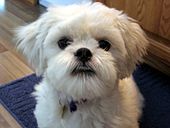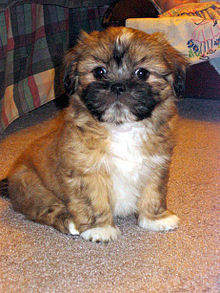Lhasa Apso
| Lhasa Apso | |||||||||
|---|---|---|---|---|---|---|---|---|---|
 A male golden Lhasa Apso in show clip | |||||||||
| Other names | Lhasa Terrier | ||||||||
| Common nicknames | Lhasa | ||||||||
| Origin | Tibet | ||||||||
| |||||||||
| Dog (domestic dog) | |||||||||
The Lhasa Apso (lha-sah ap-so) is a non-sporting dog breed originating in Tibet. It was bred as an interior sentinel in the Buddhist monasteries, who alerted the monks to any intruders who entered. Lhasa is the capital city of Tibet and apso is a word in the Tibetan language meaning "bearded," so Lhasa Apso simply means "long-haired Tibetan dog."
Appearance


Lhasas Apsos should ideally be 10.75 inches at the withers and weigh about 14-18 pounds (between 6kg and 8kg). The females are slightly smaller, and weigh between 12-14 pounds (between 5kg and 7kg). The breed standard requires dark brown eyes and a black nose, although liver coloured lhasas have a brown nose which makes them unsuitable for the show ring but still make great pets. Texture of the coat is heavy, straight, hard, neither woolly nor silky, and very dense. A Lhasa's coat should be of good length if it is for the show ring but a lot of people who keep lhasas as pets getting it trimmed into the teddy bear cut by a groomer. All colors are equally acceptable for the show ring as long as they have a black nose. Lhasas can be with or without dark tips to ears and beard. The tail should be carried well over the dogs back. The breed standard currently used by the American Kennel Club was approved July 11, 1978. [1] Lhasas can change colour as they get older. Some start off with a dark brown coat with tan and white splotches, but when their hair is cut or it grows naturally, their colour can turn much lighter. Lhasas are often compared to the fictional teddy bear warriors know as "ewoks" in the star wars universe.[citation needed]
Temperament
Having been bred as an indoor monastary sentinel dog by the Tibetan Buddhist monks, Lhasa Apsos tend to be alert and have a keen sense of hearing with a rich, sonorous bark that belies their size (some are known as "singers"). The ideal Lhasa temperament is to be wary of strangers while being loyal to those closest to them.
Lhasa Apsos, although small, can exhibit brief periods of explosive energy. Nonetheless, Lhasas in general are not one of the more active dog breeds and will often sit for hours on a bed or sofa just listening for intruders. Most Lhasa Apsos are not fond of long walks and they typically regard a yard as a perimeter to be patrolled at infrequent intervals, rather than a playground. However, in snowy weather their Tibetan heritage may surface. With heavy hair protecting their toes, they are quite comfortable in the snow and may become more playful than they are in warmer weather. Having been developed in the rugged terrain of the Himalayas, they are surprisingly sure-footed and may scamper up and down nearly vertical snowy cliffs with the confidence of mountain goats.
The breed has a high incidence of the alpha instinct, which leads to unique personality traits. Many Lhasa Apsos are highly tolerant of solitude and do not long for the companionship of other dogs. They can be headstrong and difficult to train.
Unique personality characteristics of Lhasa Apsos have gained them a reputation in some circles as being a very emotive breed that in some cases prove themselves to be completely fearless. They take their role as guardians of the family very seriously and can be quite assertive about not allowing a visitor to enter the home whom they judge as untrustworthy. This trait, coupled with their solitude tolerance and low energy level, has made the breed popular with people who live alone in small quarters, but it can be a problem if the "untrustworthy" visitor is a mooching friend or a cranky relative.
Lhasas Apsos generally are not very good with small children because they don't tolerate rough play and are not averse to issuing a "correction" for behavior they deem inappropriate. While an Apso can be integrated into a family with small children, it requires a great deal of time, effort, training and supervision of dog and children -- something many families cannot or will not provide. The vast majority of Apsos in rescue are there because of "child issues." They have either snapped at or bitten a child, or it is only a matter of time before such an incident occurs in the household. For this reason, many rescues will not place a dog in a home with children under the age of 10-12 years of age.
If properly trained, the Apso will come to appreciate bathing, hair combing and clipping. The Lhasa Apso is a long-lived breed, with some living in good health into their early 20s. There are few health problems specific to the breed. Their vision may deteriorate with age but they are not sight-oriented dogs and they endure blindness with few noticeable changes in behavior.
Because of the tendency toward alpha behavior, an intact male Lhasa Apso can be extremely dominant and aggressive toward other intact male dogs, even much larger ones, and obstinate about marking territory with urine. Neutering at an early age is strongly recommended.
History
The heavy coat of Lhasas can also be explained by the geographical features of Tibet: the temperature frequently drops below freezing thus making it hard for a dog to survive without sufficient insulation. Lhasas were rarely groomed by their owners thus allowing the breed to adapt to the harsh weather, although when they are in warm climates, such as the south-western U.S., many owners prefer to have the coats trimmed.[citation needed]
In 1901 Mrs. A. McLaren Morrison brought the Lhasa Apso to the UK where it was registered as an official breed in The Kennel Club in 1902.[citation needed]
The original American pair was a gift from Thubten Gyatso, 13th Dalai Lama to C. Suydam Cutting, arriving in the United States in the early 1930s. The American Kennel Club officially accepted the breed in 1935 in the Terrier group, and in 1959 transferred the breed to the Non-Sporting group.[1]
Recently, DNA Analysis has identified the Lhasa Apso as one of the 14 most ancient dog breeds. Archeological evidence indicates that it was originally a kitchen-midden scavenger traveling with the prehistoric nomads of central Asia. [2] The breed has incredibly good hearing and this is why they were used in Tibet as ears for the old Tibeten monks who were hard of hearing so that the monks could be alerted by the dogs sharp high pitched bark if there were any intruders.
"Hypoallergenic" Breed
Like most mammals, all dogs slough off dander ("loose scales formed on the skin and shed from the coat or feathers of various animals, often causing allergic reactions in susceptible persons") as well as saliva and even more unsavory bodily excretions. Since dander and many other allergens become trapped in hair, and shed hairs are light enough to spend considerable time airborne indoors before settling to the floor to be removed during housecleaning (an activity which can, ironically, help them stay airborne), shedding of the coat is a typical way in which housepets spread their allergens in a domestic environment.
Coming from the extremely cold weather of the Himalayas, the Apso has a double coat ... an undercoat which is soft and will shed out; and an outer coat consisting of coarse outer guard hairs. Most owners who do not show their dogs keep their Lhasa Apsos in a "puppy clip," which requires frequent bathing and grooming and further reduces the amount of allergens present. For these reasons, many people with allergies can co-exist with the low-shedding breeds, i.e., Lhasa Apso, Poodle, Shih Tzu, Maltese, etc.
Hybridiziation
The Lhasa Apso's unique and almost feline personality does not make it a popular gene pool for crossbreeding with other dogs. Mis-mating, even with dogs of vastly different size, is usually the accidental result of the aggressive behavior of both intact male and female Lhasa Apsos, and is a good reason to have the dogs spayed or neutered.
Cross-breeding is sometimes performed deliberately to create one of the "designer breeds" ... generally used as a marketing ploy by unscrupulous breeders.
Miscellaneous

- The Brazilian comic series Monica's Gang features a Lhasa Apso named Fluffy which belongs to Jimmy Five.
- In the animated series Spider-Man and his Amazing Friends, Peter's Aunt May owns a lhasa apso named Ms. Lion.
- Dougal of The Magic Roundabout is based on this dog breed
- Known to suffer from Sebaceous Adenitis - Sebaceous Adenitis is a hereditary skin disease that occurs primarily in Standard Poodles, but has also been reported in a number of other breeds, including the Lhasa Apso.
- Known to suffer from the genetic disease Progressive Retinal Atrophy which can render them blind. Ethical, responsible breeders will have their breeding dogs checked yearly (CERF'd) by a canine ophthomalogist to check that they are not developing the disease, which is heritable in offspring.
- Kidney disease is a genetic problem in the breed.
- On a 1972 episode of The Price is Right, a Lhasa Apso puppy was the first item up for bids.
- Lhasa Apso has also appeared in at least one episode of the Simpsons. In an episode Three Gays of the Condo in which Homer moved in with a couple of gay men homer started to act like a gay man and got a Lhasa Apso.
References
- ^ American Kennel Club: "Lhasa Apso History"
- ^ Science: Search query on article
